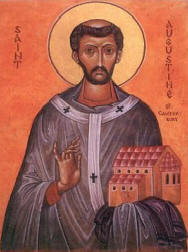| Saints and Theology of the Heart - St. Augustine of Canterbury |
|---|


Feast: May 27
See also:
The nation of the Angles was bathed with the light of holy faith - letter of Pope Gregory the Great
Benedictine Monk of Rome, friend of Pope Gregory the Great who was sent to England as the head of a group of monks to reintroduce Christianity, which had declined with the fall of the Roman empire. He converted King Ethelbert (Aethelbert) and was the first Archbishop of Canterbury. He organized the Church and instilled the Christian faith in that people, respecting their ancestral traditions wherever possible.
Although Great Britain had been evangelized in apostolic times, it had fallen back into idolatry after the Saxon invasion in the 5th and 6th centuries. When the king of Kent, Ethelbert married a Christian princess, Bertha, the daughter of the king of the Franks, she asked that a Church be erected and some priest brought to celebrate the sacred rites there. When Pope Saint Gregory the Great heard the news, he judged that the time was ripe for the evangelization of the island. He entrusted the mission to the humble prior of the Monastery of Saint Andrew, Augustine.
In the year 597 he left Rome, leading a group of forty monks. He was stopped at the island of Lérins. There he was terrified by the stories he was told about the Saxons and returned to Rome to ask the Pope to change his plans. Pope Gregory named him abbot and later Bishop. Upon arriving to the British island of Thanet, the king went personally to receive him in person.
The missionaries advanced solemnly, singing the litanies in procession. The king accompanied the monks to their residence that he had prepared for them in Canterbury, located half way between London and the sea. There was built the abbey that became the center of English Christianity. The work of the missionary monks had unexpected success. The king himself asked to be baptized, leading thousands of his subjects to embrace the Christian religion by his example.
The Pope was overjoyed with the news that arrived in Rome, and expressed his satisfaction in written letters to Augustine and the queen. Along with a new group of men to join him in this work, the Holy Pontiff sent his pallium and the official naming of Augustine as the Prime Archbishop of England. At the same time, he paternally admonished him not to become prideful for the success achieved and at the honor of the high charge that had been conferred upon him. Following the indications of the Pope for the repartition of the ecclesiastical territories, Augustine erected other Episcopal Sees, in London and Rochester, consecrating Mellitus and Justus as Bishops.
The holy missionary died on May 26, 605 and was buried in Canterbury in the Church that bears his name.
Return to the Main Page on the Saints...
 Return to main page www.piercedhearts.org This page is the work of the Servants of the Pierced Hearts of Jesus and Mary |
|---|